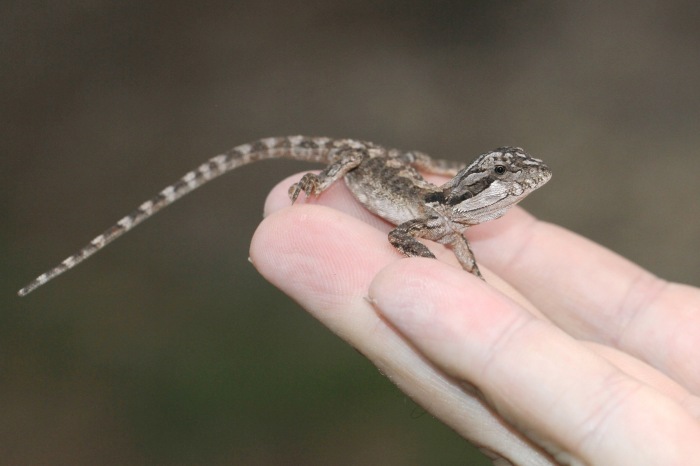Another year begins, and a sequel to last year’s Pine Mountain Big Day was on the cards. As I was flying back from Cairns on January 1st, I had to delay it until the 5th. Otherwise, the same rules applied; I was to see and/or hear as many species of birds as possible within a single day within the Pine Mountain area. As for last year, I defined this area as bounded by the Warrego Highway to the south, the Brisbane Valley Highway to the west, and the Brisbane River to the east and north. Only this year I had a target to beat: my last year’s tally of 124 species.
I kicked off the big day at midnight, instead of “sleeping in” to 1:30 AM as in 2018. It was therefore all the more impressive that I had a volunteer accomplice this year, in the form of Shealagh Walker. The first bird we managed to see on our big day was actually the same species as last year: a Tawny Frogmouth. Before then, though, we had already heard a Brown Quail, Pale-vented Bush-hen and Channel-billed Cuckoo break the night’s silence with their cries and shrieks.
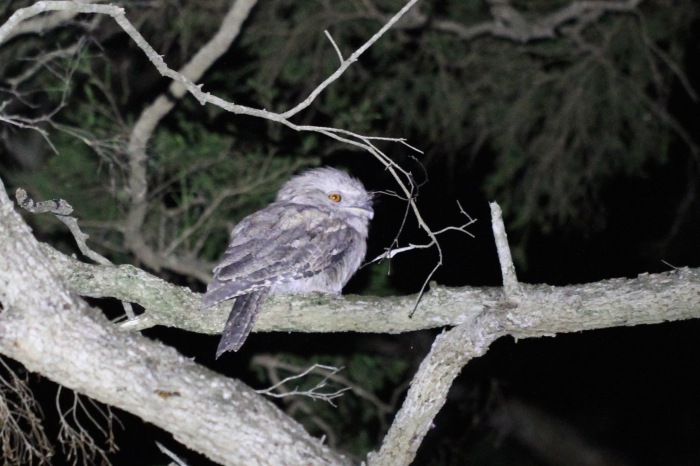
The walk through the vine scrubs along the northern end of Riverside Drive proved surprisingly quiet, with only some distant Bush Stone-curlews, Southern Boobooks and Australian Owlet-nightjars heard. The highlight of the walk was probably this Squirrel Glider.
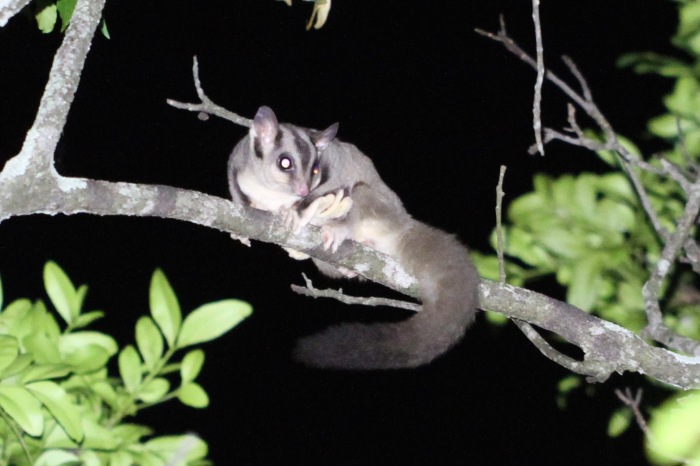
In light of the poor returns from the vine scrub, the earlier start was fortunate, as it allowed us time to explore some of the eucalypt forests at the southern end of Riverside Drive, as well as in the Pine Mountain Bushland Reserve. This turned out to be very productive, both for birds and other animals. Here, we heard a Barn Owl screech a few times, saw more Tawny Frogmouths and finally managed to find a Powerful Owl as it hooted for many minutes as the night’s end drew near. The highlights again, though, were the mammals! I had the best views I’ve ever had of a Feathertail Glider, as it hopped among the branches of a tall eucalypt before sailing into a nearby tree. Then, we spotted another Squirrel Glider and a family of Common Brushtail Possums, including a baby. But the higlight for me was a wonderfully close look at a Brush-tailed Phascogale as it hopped among the low bushes just metres away. The small lens I had with me was more suited to reptiles and frogs than fast-moving mammals, but I managed a couple of poor shots before it eventually lept onto the ground and scampered off into the night.
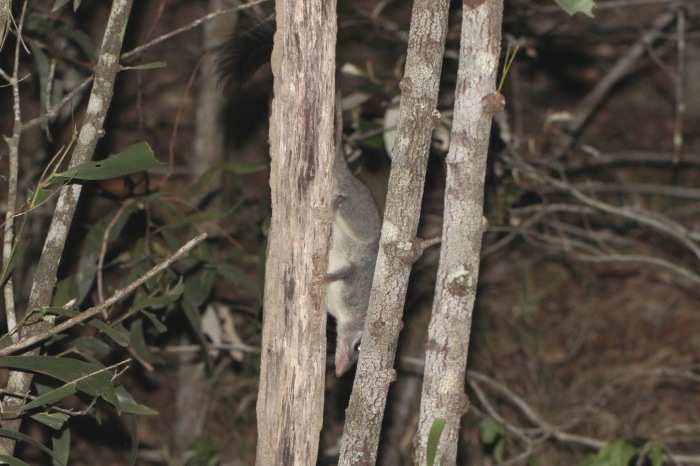
As the dawn began to break, we headed to the dam in the far north of the area, in the corner of E Summervilles Road and Pine Mountain Road. For the second year in a row, this wetland produced an amazing variety of ducks, which included uncommon species such as Pink-eared Ducks, Australasian Shovellers, Chestnut Teal and Wandering Whistling-ducks. In the surrounding fields, Brown Songlarks, Tawny Grassbirds and Golden-headed Cisticolas were doing their display song flights. We were to return to this wetland three times in total during the day, and each time there were different species present: Yellow-billed and Royal Spoonbills, Latham’s Snipe, White-necked Herons, White-faced Herons, Red-kneed and Black-fronted Dotterels, and various cormorants.
While it was still early and cool, we headed to the dry eucalypt forest along the Pine Mountain Rail Trail. The first thing I noticed was how much quieter the cicadas were this year compared to the last. What a relief, as it made the birding much easier—and more pleasant! It wasn’t too long before we found Speckled Warblers, Fuscous Honeyeaters, Black-chinned Honeyeaters, and other specialties of the open forest.
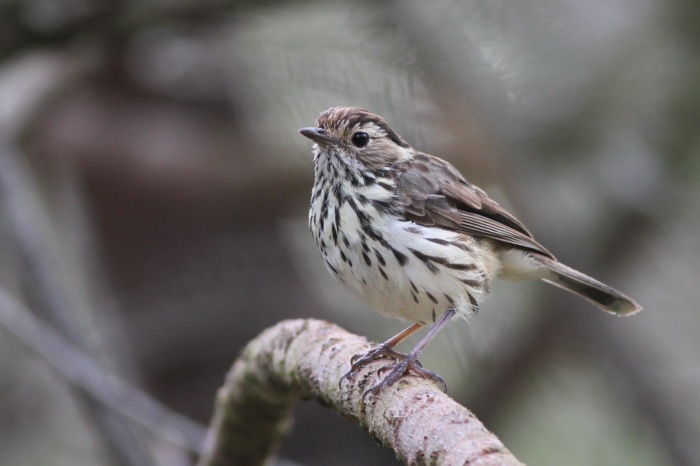
I was most surprised to hear the familiar begging screeches of a young Grey Goshawk coming from exactly the same tree as I saw a family last year. This near threatened species obviously breeds here regularly.
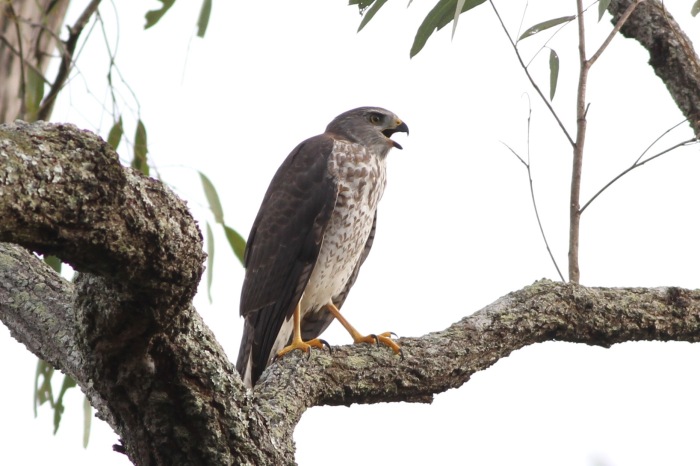
Satisfied with our haul, we headed back to the vine scrubs around home to find some rainforest species to add to our list. It was about 7:30 AM by this point, but the day had already heated up and it was fairly quiet birdwise. Still, we managed to add Brown Cuckoo-doves, Emerald Doves, Rose-crowned Fruit-doves, White-eared Monarchs, Little Shrike-thrushes, Large-billed Scrubwrens and other rainforest species to our list.
Afterwards, we headed off to the Kholo Gardens to add the tame Australian Brush-turkeys and, like last year, an Osprey flying along the Brisbane River. Across the river, Comb-crested Jacanas fed on the waterlily leaves. We were especially surprised to hear King Quail calling from the long grass along the banks of the river. This is only the second place I’ve ever recorded this species in the Ipswich area.
After a quick stop at the relatively new Bell Miner colony at the southern end of Riverside Drive, we discussed how best to spend the second half of the day. Last year, I spent much of the middle of day exploring the vine scrubs, but decided that, this year, we would focus more on open farmland areas, in the hope of getting more raptors and waterbirds. We broke even on this gamble; while we missed out on rainforest birds like Spectacled Monarchs, Black-breasted Buttonquail, Topknot Pigeons and Brown Thornbills, we picked up four birds of prey I missed last year (Black-shouldered Kite, Spotted Harrier, Nankeen Kestrel and Australian Hobby). The main advantage to our new approach was that we could do this from the car, rather than hiking around in the middle of a hot, summer’s day.
By early afternoon, the returns on our efforts were fast diminishing. Still, we managed to find a group of Grey-crowned Babblers here and a flock of Fairy Martins there. Also, after somehow missing Common Bronzewings throughout the day, I was amazed to spot one sitting on a nest above Borallon Station Road while I was driving past.
The final species of the day was the Plum-headed Finch, a small flock of which was at the E Summervilles Road dam on my third and final visit. This cute little bird brought my tally to 130 species, an improvement of 6 species over last year! In total, I missed 15 species recorded in 2018, but gained 21 new species. This is quite a diversity of birdlife in a relatively small patch of semi-rural southeast Queensland and, in my biased opinion, well worth the 17 hours spent searching and 20.6 km walked!
As an aside, on my return home I was greeted by a clutch of three cute hatchling Bearded Dragons that had somehow found themselves in my greenhouse. I’m guessing the mother must’ve laid her eggs beneath the frame. At least they’ll be safe from kookaburras and butcherbirds in there!
